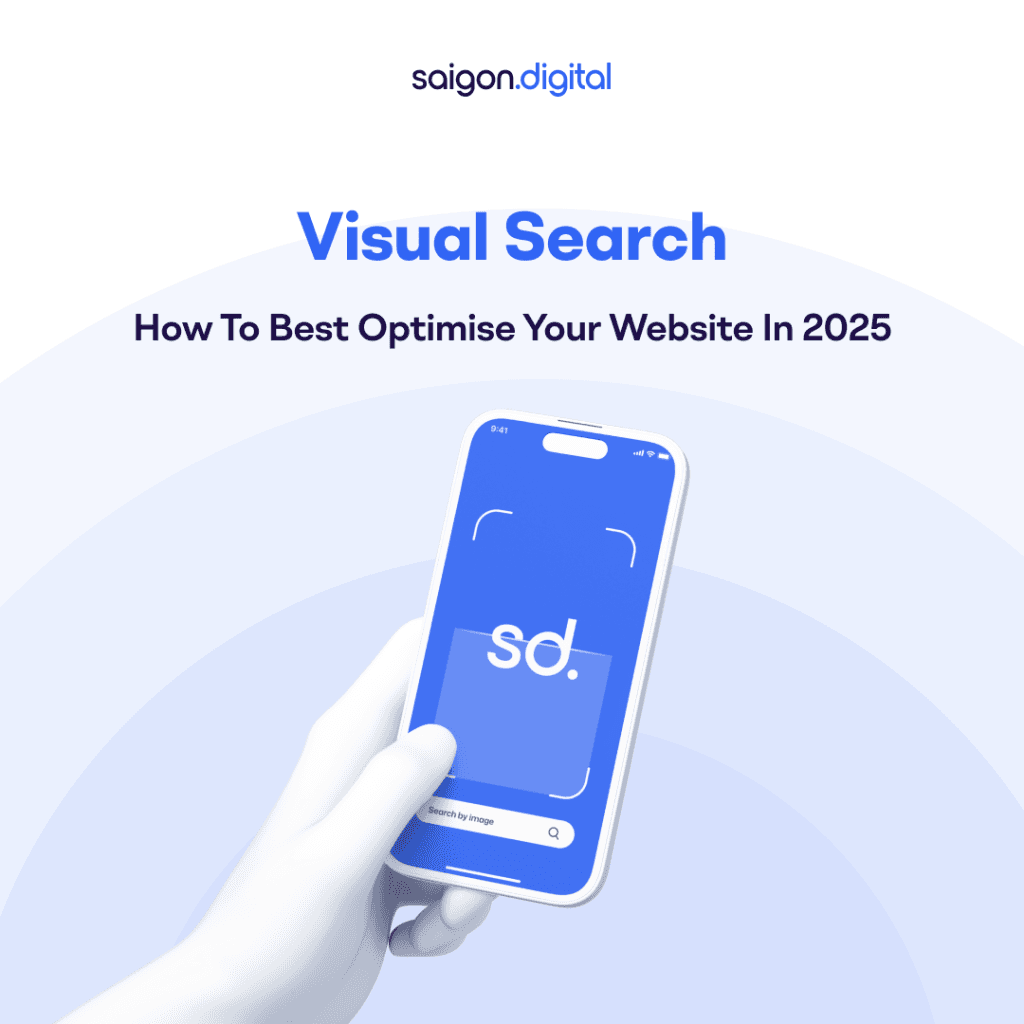
What Is Visual Search?
Visual search refers to the use of real-world images to conduct searches online, instead of using text-based queries. Think photos, screenshots, or visual inputs. Unlike image search (where users type a keyword to find images), visual search allows users to upload or capture an image to initiate a search. Imagine you see someone wearing a unique pair of trainers. Rather than describing them with uncertain words like “white sneakers with blue swoosh and red heel tab”, you simply snap a photo and upload it to a visual search engine. In seconds, the system identifies the product and shows you where to buy it. This technology relies on computer vision, AI, and machine learning to analyse images, detect objects, and retrieve matching or contextually relevant results. It offers a faster, more intuitive way for users to interact with content. And for brands, it opens a powerful new channel to reach their audience.The Evolution of Visual Search Engines
Leading tech companies have been pouring resources into visual search innovation for years. Let’s explore some of the major players:Google Visual Search: Google Lens
Google Lens is Google’s flagship visual search tool. Users can take a picture or use an existing image to:- Identify landmarks, animals, or plants
- Translate foreign text
- Shop for products they see offline
- Extract text from images
- Search contextually relevant results
Bing Visual Search
Microsoft’s Bing Visual Search is another strong contender. Similar to Lens, it allows users to upload images or use visual clues to search. Bing’s system places strong emphasis on product recognition, allowing users to click on objects within an image to find related products or items. While Google Visual Search dominates the space due to Android's market share and search engine supremacy, Bing Visual Search is popular among desktop users and is well integrated with Microsoft Edge.Pinterest and Other Platforms
Visual-first platforms like Pinterest have also built their own visual search technology. Pinterest Lens allows users to take a photo and receive stylistically similar results or related pins. This has proven particularly effective in fashion, interior design, and lifestyle industries.Why You Should Optimise for Visual Search
Here’s why you should optimise for visual search:Reason 1: Changing User Behaviour
Consumers are increasingly drawn to visual-based interactions. As digital natives grow up with image-first platforms like Instagram, Snapchat, and TikTok, their search habits evolve too. They expect fast, intuitive, visual-first answers, not just blue links.Reason 2: Increased Product Discovery
Visual search shortens the path to purchase. When a user sees a product they like, they can act on it immediately. This gives e-commerce businesses an edge, allowing users to go from interest to conversion in seconds.Reason 3: Voice and Visual
Just as voice search SEO has required optimising for spoken queries, visual search SEO requires a different way of thinking about how your content is discovered. Both are driven by a desire for faster, more natural search experiences, and they often work together. For example, a user might speak a query, then refine their results by taking a photo.Reason 4: Competitive Advantage
Visual search is still an underused SEO strategy. Brands that adapt early stand to gain significant visibility and market share before it becomes the norm.Visual Search SEO: How to Optimise Your Website
As visual search grows in relevance, so does the necessity to strategically optimise your content to be recognised, ranked, and retrieved by a search engine. Below, we break down each key area of visual search optimisation in detail, providing practical advice and examples along the way.Strategic Image Production
Why it matters : Images are the centrepiece of visual search. The quality, composition and context of your visuals directly affect their ability to be understood by search algorithms. The more structured, relevant and brand-aligned your visuals are, the more likely they’ll be matched in Google and Bing Visual Search, or similar tools. Key strategies :- Use high-resolution images: Clarity matters. Blurry, pixelated or poorly lit images make it difficult for computer vision to identify details.
- Multiple angles and perspectives: Offer top-down, profile, and contextual views. For example, a shoe might be photographed from the side, above, below, and on-foot. This helps the search engine match it from any user photo angle.
- Consistent backgrounds: Use clean, neutral backgrounds (especially for eCommerce products). A white or light grey background ensures object clarity without distractions.
- Contextual shots: Go beyond product-only visuals. Show items in use such as a coffee table in a furnished living room or a jacket being worn in an urban setting. These help AI understand the object’s purpose and context.
- Include human interaction: Where relevant, show people using or wearing the product. For example, a model wearing a scarf demonstrates scale and fit, something flat lays often fail to convey.
- Brand identifiers: Ensure any logos or distinctive features (patterns, colourways, packaging) are visible. This aids recognition and brand authority.
Precise Filenames and Alt Text
Why it matters : Alt-text and filenames are critical for search engines to interpret images. While visual search uses computer vision, it still relies heavily on textual cues to verify context, especially when building search result snippets. Best practices :- Filenames:
- Use hyphen-separated phrases.
- Avoid generic terms like IMG0001.jpg.
- Example: womens-leather-tote-bag-brown-front.jpg.
- Alt-text:
- Be detailed but not spammy.
- Describe the object, its colour, material, position, and use if applicable.
- Example: “Large brown leather tote bag with zip-top and gold metal accents, sitting on a white table.”
- Voice SEO overlap:
- Use phrasing that reflects how people speak. This supports both visual search SEO and voice search.
- Example: Instead of “leather-bag.jpg”, use “Where to buy brown leather tote bag UK”.
- Don’t stuff keywords: Write naturally, as if describing the image to a visually impaired person.
Image Sitemaps and Discoverability
Why it matters : If Google and Bing can’t find your images, they can’t index them for visual search. An image sitemap tells search engines where your visual content lives, ensuring all assets are discoverable. >> Read more: A Comprehensive Guide to Sitemaps Implementation tips :- Create an image-specific XML sitemap:
- Include all image URLs with relevant <image:image> tags.
- Attach images to their appropriate page entries, especially product and blog pages.
- Use self-hosted image paths:
- Avoid hosting images on third-party servers (like a CDN without indexing capabilities).
- Make sure the image URLs are accessible and not blocked by robots.txt.
- Compress without sacrificing quality:
- Use next-gen formats like WebP or AVIF to ensure fast loading while retaining detail.
- Fast loading = better crawlability and user engagement.
- Avoid lazy-loading mistakes: Ensure lazy-loaded images use data-src or are triggered correctly so that crawlers can see them.
Schema Markup
Why it matters : Schema.org markup provides machine-readable metadata about your images and content. For visual search engines, this structured data strengthens confidence in what the image is showing, especially in commerce or recipe scenarios. Types of schema markup for visual search SEO :- ImageObject:
- Used to describe standalone images.
- Fields: caption, creator, datePublished, license, contentUrl, thumbnailUrl.
- Product schema:
- Ideal for eCommerce listings.
- Fields: name, image, offers (price, availability), brand, sku, gtin.
- Recipe schema:
- Include image with Recipe, prepTime, cookTime, nutrition, recipeYield.
- Use JSON-LD (JavaScript Object Notation for Linked Data) format.
- Validate your markup using Google's Rich Results Test.
- Update regularly as products or pages change.
Performance and Technical Considerations
Why it matters : Google’s page experience signals, such as Core Web Vitals , influence how your content, including images, ranks. Poorly performing images can tank your SEO across the board, including visual discovery. Optimisation checklist :- Compress images using tools like TinyPNG or Squoosh.
- Use responsive images with srcset and sizes attributes to serve the right size per device.
- Defer offscreen images with lazy loading (loading="lazy" in HTML).
- Use CDN (Content Delivery Network) for global delivery speed, but ensure images are crawlable.
- Optimise for LCP: Ensure largest image on page loads within first 2.5 seconds.
Leverage Visually Rich Platforms
Why it matters : Visual discovery doesn’t happen solely on Google. Platforms like Pinterest, Instagram and even TikTok are visual-first ecosystems where discovery and purchase often start. Being optimised here amplifies your reach. Platform-specific tips :- Pinterest:
- Enable Rich Pins using metadata from your product or article pages.
- Use vertical image dimensions (2:3 ratio) and engaging thumbnails.
- Write keyword-rich Pin titles and descriptions.
- Instagram:
- Enable Shopping with product tagging in Stories, posts, and Reels.
- Ensure product catalogue is synced via Facebook Business Manager.
- Prioritise UGC: share and reshare customer-tagged content.
- YouTube & TikTok: For hybrid discovery, include thumbnail optimisation and visual cues in video frames.
- Google Merchant Centre:
- Submit a feed with product image URLs, names, brands and prices.
- Helps products appear in Google Shopping and Lens search results.
Testing and Iteration
Why it matters : Optimisation is not a “set-and-forget” strategy. Visual search results change with algorithm updates, competitive imagery, and evolving AI recognition standards. Regular testing ensures your visuals stay relevant. Ongoing strategy :- Test with Google Lens:
- Use the app to photograph your own products/pages and see what’s surfaced.
- Note if competitors show up instead—analyse why.
- Try Bing Visual Search:
- Upload your images directly on Bing.com/visualsearch.
- Use the cropping feature to check partial recognition accuracy.
- Check platform analytics:
- Pinterest: Review “Visual Discovery” metrics in Creator Hub.
- Instagram: Monitor tagged product views and post engagement.
- Update based on test results: If Google Lens misidentifies your beige coat as a trench coat, consider adding more specific alt-text and schema data.
Visual Search and Voice Search SEO: A Combined Strategy
Visual search and voice search may use different inputs (image vs. speech), but their optimisation strategies share similarities:Conversational Queries
Voice search SEO relies on natural language, full sentences, question phrases, and long-tail keywords. Similarly, optimising your content to answer "what is visual search" or "how does visual search work" improves your chances of being featured in rich results or AI-driven search previews.Structured Data and Context
Both visual and voice assistants pull from structured data and well-organised content. Marking up content with schema, and using proper headings and FAQs, benefits both types of search.Fast, Accessible, and Direct Content
Whether a user is speaking to their phone or pointing their camera at a product, they want fast, accurate answers. Your job is to deliver those answers through well-optimised content and visuals.The Future of Visual Search
Visual search is evolving rapidly. With developments in AI, AR (augmented reality), and real-time object recognition, we can expect even more immersive experiences in the near future:- Visual translation and accessibility enhancements
- Instant product identification via smart glasses or wearable tech
- Real-time search overlays in physical stores





